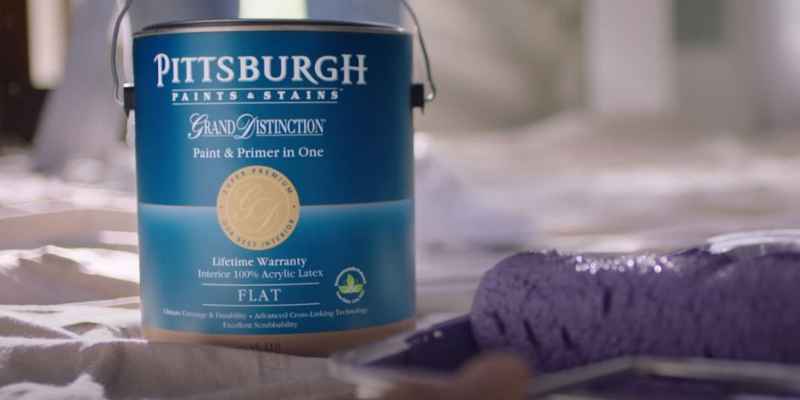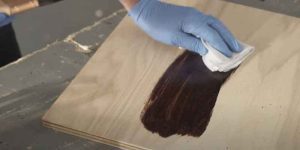When paint must be tinted, it means adding pigment to it to create a specific hue or shade. Tinting can also involve adding small amounts of another color to adjust the intensity of a primary color.
Tinted paint is commonly used in interior and exterior painting to match specific color preferences or to achieve a particular aesthetic for a space. Tinting paint can also help reduce the number of coats needed to achieve the desired color and enhance the overall quality and appearance of the finished product.
We’ll explore what tinted paint is, why it’s used, and how to tint paint yourself to achieve your desired color.
What Is Paint Tinting?
When a paint must be tinted, it means that a specific color will be added to it to achieve the desired shade or hue. This is commonly done to match specific color preferences or to create a particular aesthetic in both interior and exterior painting.
Tinted paint is made by adding a specific color pigment to regular paint.
Definition and Explanation:
What is Paint Tinting? Paint tinting refers to the process of adding small amounts of colorant to a bucket of white paint to achieve a desired color. These colorants are highly concentrated and should be added slowly to avoid over-tinting. When creating a custom color, it’s important to take into account lighting and the surrounding colors to ensure the finished product looks the way you want it to.
Purpose of Tinting Paint:
The purpose of tinting paint is to achieve a desired color that cannot be achieved by using just white paint. Adding color to the paint also makes it more durable and resistant to fading. Paint that has been tinted can also help hide imperfections such as nail holes or cracks in the wall. Tinting can be done in various ratios to create different shades of the desired color. When done correctly, tinting paint can give a professionaly done look to any space, whether it is a commercial or residential property.
In order to tint paint, it’s important to have a good understanding of color mixing and how different hues interact with each other. When done correctly, paint tinting can help bring any space to life with beautiful, custom colors.
How To Tint Paint
When purchasing paint, “must be tinted” means that the color is not pre-mixed and will require additional mixing with pigment. Tinting can be done at a paint store or by adding colored paint to the primer or base color. Tinted paint refers to a color that has been lightened by adding white or other colors to achieve a specific hue or shade.
Painting a room can be an exciting way to renovate your living space. You get to choose a new color scheme or give your existing décor a fresh, updated look. However, for those new to home improvement, getting acquainted with the terminology can be confusing. One term that people often encounter is “must be tinted” on paint cans. In this blog post, we will explain what tinting paint means and provide some helpful tips on how to tint paint effectively.
Methods Of Tinting Paint
There are two primary methods of tinting paint: using a paint store color-matching system or DIY tinting. Most paint stores offer a color-matching system where you bring in a sample of the color you want, and they use a computer to create a matching hue. This is a convenient and precise way to tint your paint, but it can also be expensive.
Alternatively, you can DIY tint your paint by adding small amounts of colored paint into the base paint. It’s essential to mix thoroughly and do a little color testing to ensure you achieve the desired shade.
Tips For Tinting Paint At Home
Tinting your paint at home is a cost-effective way to customize your paint color. Below are some tips to consider when tinting your paint:
- Use quality paint and tint – high-quality materials will result in a better finish and reduce the number of coats required.
- Measure your materials correctly – precise measurements ensure color accuracy and consistency.
- Test your color – make sure to test the color before you paint the entire room to ensure the color matches your vision.
- Do multiple coats – sometimes, you will need to do more than one coat to achieve the look you want.
In conclusion, understanding the meaning of “must be tinted” on paint cans is essential to achieve the desired outcome of your painting project. Tinting your paint can help you achieve the exact color you want and save you time and money. By following the above tips, you can successfully tint your paint at home and create a beautiful, personalized living space.
Difference Between Tinted And Painted

When referring to paint, “must be tinted” means that you need to add a small amount of another color to the base color to create a different hue or tone. Tinting paint is often done to create pastel shades or adjust the intensity of a color.
Tinting the primer can also reduce the number of coats needed when painting.
When you hear the words ‘tinted’ and ‘painted’, you may assume they are the same thing but in the world of paint, they have different meanings. The process of tinting involves adding a small amount of color to a paint base to adjust the color and to achieve a different tone or hue. On the other hand, painting refers to the process of applying a coat of paint onto a surface to provide color, protection, and aesthetics. In this article, we will dive deeper into the difference between tinted and painted surfaces and what the term ‘must be tinted’ means on paint cans.
Definition of Tinting and Painting
Tinting: Tinting is a process in which small amounts of color are added to a paint base to achieve the desired shade. This process is mainly used to adjust the intensity of color and to create a different tone or hue.
Painting: Painting is the application of paint on a surface to provide protection, color, and aesthetics. Painted surfaces can be done with different techniques like brushing, rolling, or spraying.
Examples of Tinted and Painted Surfaces
Tinted surfaces: Tinted surfaces can be seen in pastel colors, which are lighter versions of a color. For example, if white paint is tinted with a small amount of blue, it will result in a pastel blue color.
Painted surfaces: Painted surfaces can range from walls, furniture to cars, and appliances. The color of the paint can be chosen from a wide range of shades and hues according to the surface being painted.
When you buy paint, you might have noticed the instructions “must be tinted” or “must add colorant”. This means the paint base is pure white and needs to be mixed with a colorant or tint before it can be applied to achieve the desired color.
In conclusion, the difference between tinting and painting is quite simple. Tinting involves adding a small amount of color to a paint base to adjust the shade, while painting is the application of paint onto a surface. If you ever come across a paint can with the instruction “must be tinted”, it means the paint base is pure white and needs to be mixed with a colorant or tint before applying the final coat.
What Must Be Tinted Before Using Paint?
When painting, it’s important to tint the primer to match the finished color, which reduces the number of coats needed. You can either have a paint store add colorant to the primer or tint it yourself by adding some of the colored paint to it.
It’s crucial to tint the primer before using paint.
What Must Be Tinted Before Using Paint?
Tinting is the process of mixing pigments or colors to paint to achieve a desired shade or hue. When it comes to painting, knowing what must be tinted before using paint is essential to achieve a smooth and even color on your walls or surfaces. Below are some of the things that must be tinted before using paint.
Primer
Primer serves as a base coat that prepares the surface for painting. Tinting the primer with the color of the finished paint can reduce the number of coats needed. Paint stores can add colorant to the primer, but you can also tint it yourself by adding some of the colored paint to it. This ensures that the primer and the paint have the same shade, giving a consistent and even finish.
Base Coat
Base coat is the primary layer of paint applied to a surface. Tinting the base coat helps achieve a uniform finish in fewer coats. Adding colorant in the base coat also helps in hiding the previous color and imperfections.
Other Paint Types
Other paint types include specialty paints like enamel, acrylic, and oil-based paint. Tinting these kinds of paints not only improves the aesthetic value but also enhances the paint’s durability. Tinting also helps in color matching, giving the wall or surface a more cohesive and polished look.
In conclusion, understanding what must be tinted before using paint is crucial in achieving a flawless and professional-looking finish. Whether it’s the primer, base coat, or other paint types, tinting them with the same color as the finish will give better color consistency and coverage.
Advantages Of Tinting Paint
Tinting paint refers to the addition of colorant to a base paint, which helps to achieve a desired hue or tone. When painting, it’s beneficial to tint the primer the same color as the finished paint, reducing the need for multiple coats.
The process of tinting paint involves adding color to your paint to get a specific shade or tone. Tinted paint has many advantages that make it a preferred choice for many DIYers and professional painters. In this section, we will discuss some of the major advantages of tinting paint.
Fewer Coats Required
One of the biggest advantages of tinting paint is that it reduces the number of coats required to achieve the desired color or shade. When paint is tinted, it is easier to achieve a uniform color with fewer coats compared to untinted paint. This not only saves you time but also reduces the cost of painting. You can apply tinted paint to surfaces such as walls, ceiling, and furniture with fewer coats, giving them the desired color, and helping to hide any stains
Customization Options
Customization is another significant advantage of tinted paint. Tinting your paint allows you to get a unique hue that matches your specific requirements. Whether you are looking for a bright or a subtle color, tinting paint gives you the flexibility to achieve your desired look. You can experiment with different color combinations to create a unique look for your space.
Tinting paint can also help you match colors in your home decor. For example, you may want to match the color of your walls with your furniture, curtains, or other decorative items. Tinting your paint can help you achieve this easily and give you a cohesive look throughout your space.
In Conclusion
Tinting paint is an excellent way to achieve your desired color and save time and effort. Fewer coats are required with tinted paint, and it allows for customization options that let you get the exact look you want. Consider tinting your paint the next time you are painting your home or workspace to take advantage of the added benefits it provides.
Common Concerns About Tinting Paint
What Does Must Be Tinted Mean on Paint? Tinting refers to the process of adding pigment to a paint base to create a specific color. Tinting primer to match your final paint color can reduce the number of coats needed and give a more even tone.
It’s possible to tint primer yourself by adding some of the colored paint to it.
Adding color to paint can be a daunting task for many people. When it comes to tinting paint, there are a few common concerns that people tend to have. In this post, we’ll address misconceptions about tinting paint and color matching difficulties that you might encounter during the process.
Misconceptions About Tinting Paint
Misconceptions about adding tint to paint are widespread. One of the most common misconceptions is that tinting paint will drastically alter its original color. However, this is not true. Tinted paint will remain the same color, only lighter or darker, depending on the amount of tint added. Another misconception is that adding too much tint will result in a loss of quality in the paint, which is also not true. The quality of the paint is determined by the manufacturer, not the amount of tint added.
Color Matching Difficulties
When attempting to color match tinted paint to an existing color, difficulties can arise. One of the most significant issues is that the lighting in the room can significantly affect the appearance of the paint color. This is why it is crucial to test the paint color in the room where it will be applied before committing to the final color. Another issue is that the original color might not be a standard color, making it challenging to color-match with premixed tints. In this case, a custom tint might be necessary to achieve the desired color.
In conclusion, tinting your paint can be a straightforward process that can add a unique touch to your living space. By debunking common misconceptions about tinting paint and overcoming color-matching difficulties, you can create the desired look you envision.

Frequently Asked Questions Of What Does Must Be Tinted Mean On Paint
What Does Tinted Mean In Paint?
Tinted paint refers to a color that has white added to it, making it lighter than the original color. Tinting can be done by adding colorant to primer or by adding a small amount of colored paint to the base paint.
Tinting can also refer to adding a small amount of another color to create a different hue or tone.
What Must Be Tinted Before Using Paint?
When painting, it is a good idea to tint the primer the same color as the finished paint to reduce the number of coats needed. A paint store can add colorant to the primer, or you can tint the primer yourself by adding some of the colored paint to it.
Therefore, the primer must be tinted before using paint.
What Is The Difference Between Tinted And Painted?
Tinted paint is a color that has been lightened by adding white or a small amount of another color. It is commonly used for pastel shades or to adjust color intensity. Painted refers to any color that is applied to a surface.
Tinting primer with the finished paint color can reduce the number of coats needed. Tinting can be done by adding colored paint or pigment to a base color.
How Do You Get Paint Tinted?
To get paint tinted, you can add small amounts of tint to the base color and stir them thoroughly. Some paint stores can also add colorant to the primer to create a lighter shade. Tinting refers to adding white to the paint to produce pastel shades or adjust the intensity, while adding another hue creates a different tone or color.
It’s essential to tint the primer to the color of the finished paint to reduce the number of coats needed.
Conclusion
Tinted paint can refer to different meanings in the world of painting. It could mean a color that is lightened by adding white, or simply paint that has been mixed with a specific pigment to achieve a desired shade or hue.
Tinting the primer to the color of the finished paint can also reduce the number of coats needed. With this knowledge, you can now confidently tackle your painting project and achieve the desired results. Remember to use quality paint products and take your time to get the tinting right to achieve the desired results.


